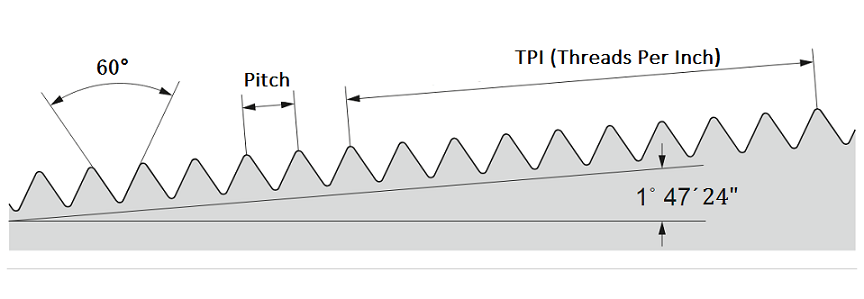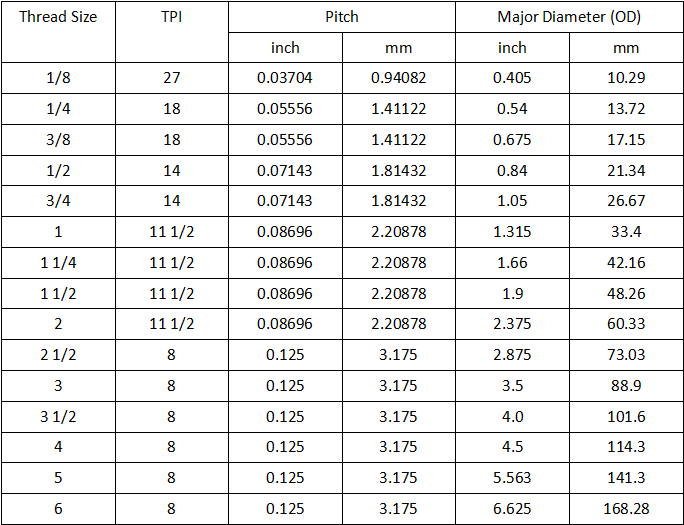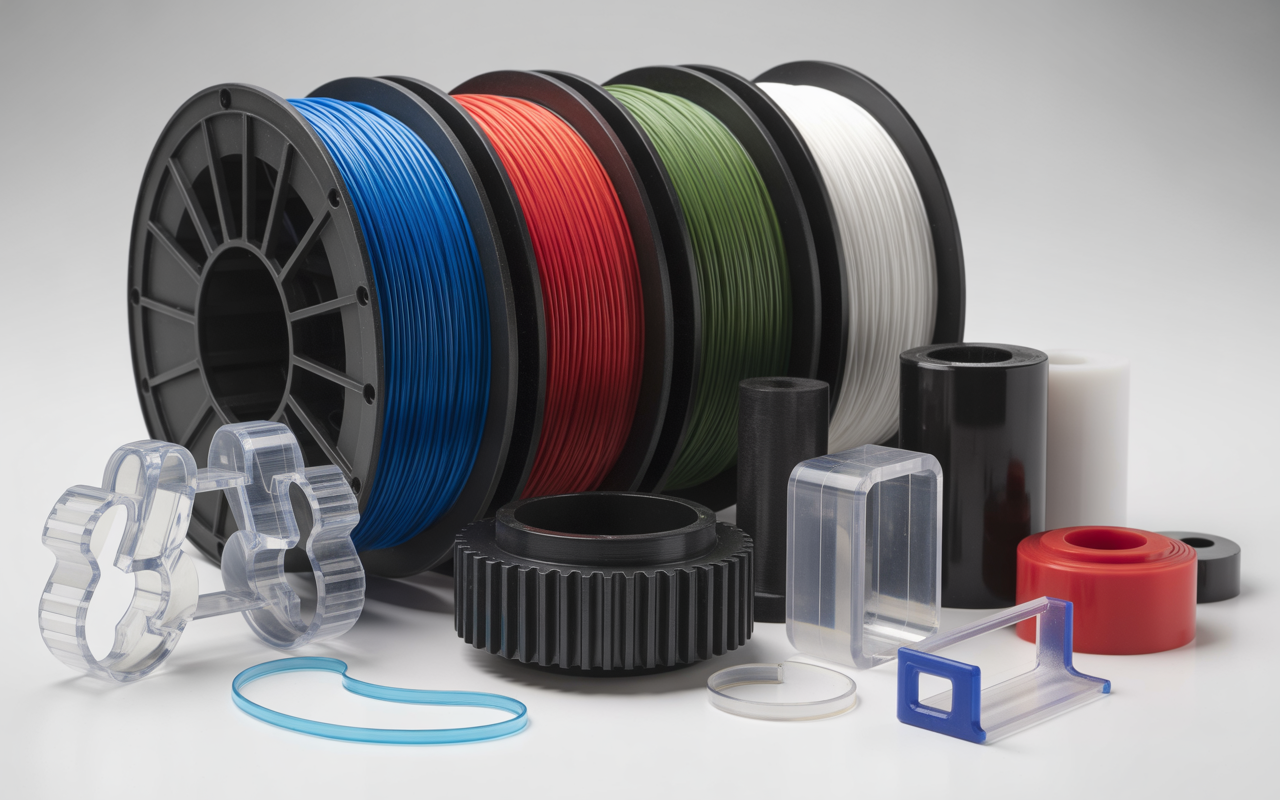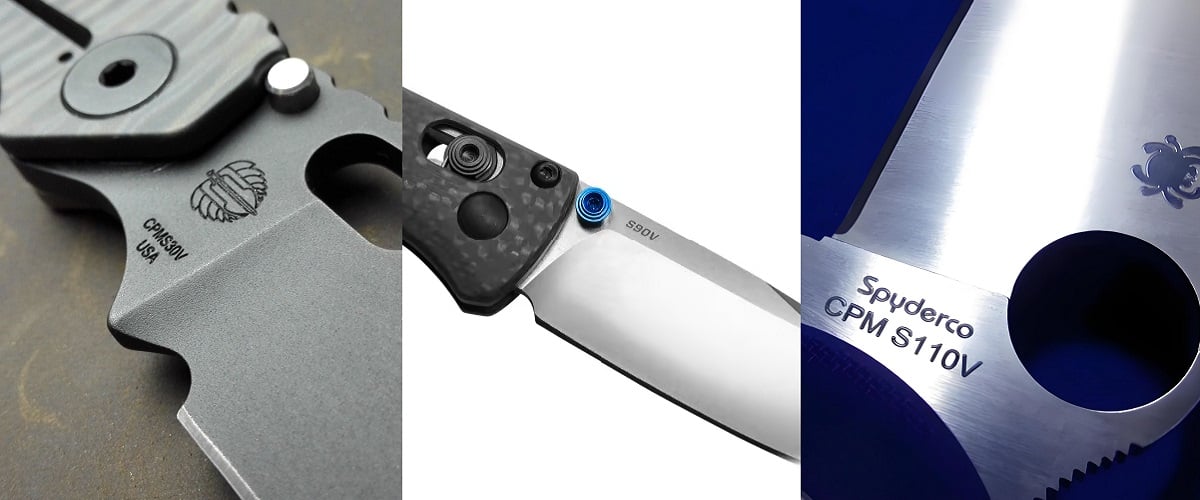G thread (also known as BSP) and NPT thread are two common pipe thread standards, which are widely used in pipe and pipe fitting connections, each offering unique features suited to different uses. Learn the key differences between G thread (BSP) and NPT thread, including their features, applications, and dimensional charts. Understand how these pipe thread standards differ in sealing mechanisms, thread angle, and industrial usage, helping you choose the best option for your pipe fitting needs.
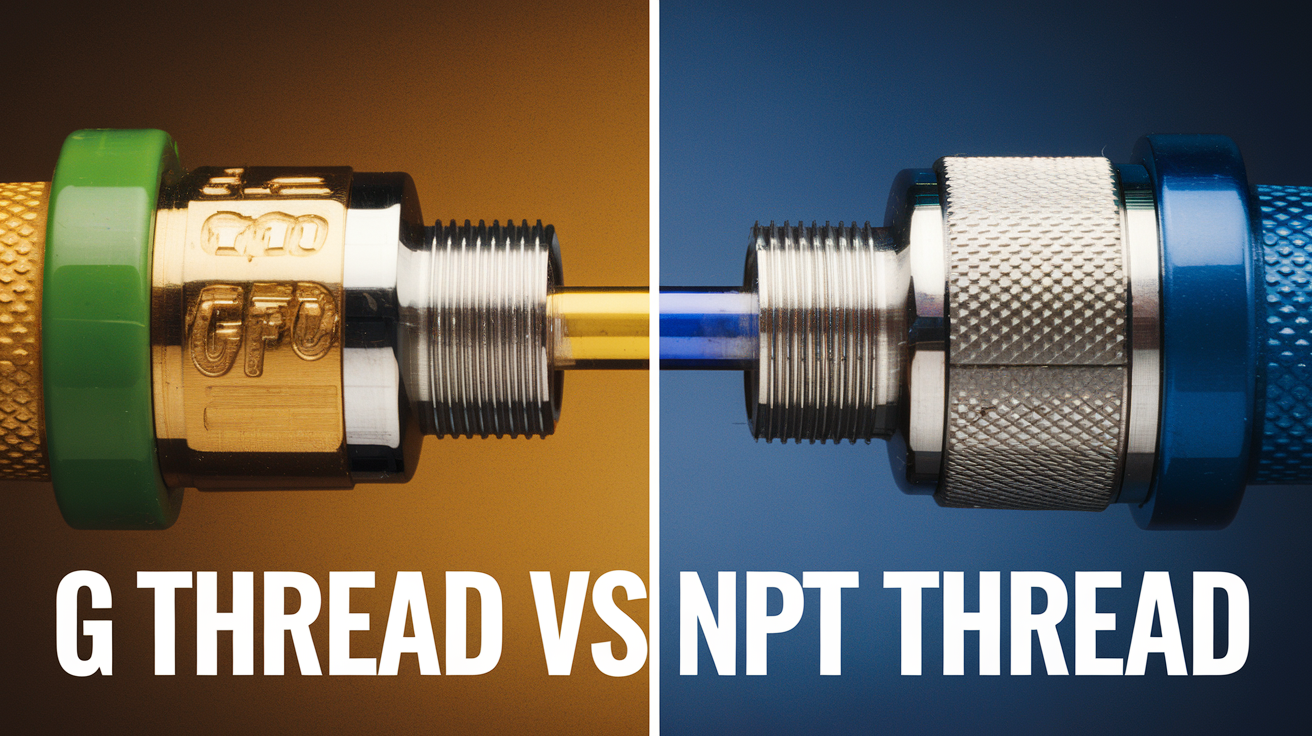
1. What is G Thread?
G thread, commonly referred to as British Standard Pipe (BSP) thread, is a 55° thread angle cylindrical pipe thread. It belongs to the Whitworth thread family and is used primarily in Europe and Asia. G threads are non-tapered, meaning both the external and internal threads are cylindrical. This type of thread is also known as a “non-sealing” pipe thread because the thread itself does not create a seal.
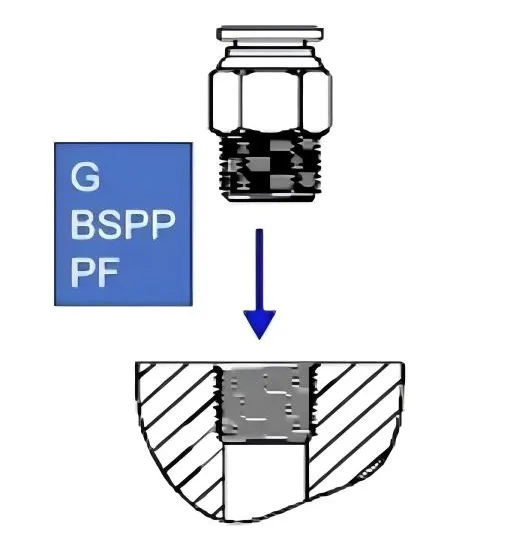
To achieve effective sealing, G threads rely on sealing materials such as PTFE tape or sealing rings. They are typically used in low-pressure applications, where higher precision in sealing might not be necessary.
NPT Thread Pros & Cons
Advantages:
- Standardized Design:
Follows the American National Pipe Thread (NPT) standard, offering good universality and interchangeability. This makes it easier to connect valves and pipes of different brands and specifications. - Easy Installation:
Installation and removal can be done using common tools like wrenches or pipe wrenches, significantly saving time and labor costs. - Good Sealing Performance:
The unique thread structure design provides reliable sealing, reducing the risk of leaks. - High Pressure Resistance:
NPT threads can withstand high operating pressures, making them suitable for pipe systems of various pressure levels.
Disadvantages:
- Limited Sealing Performance:
Under extreme high-pressure or high-temperature conditions, the sealing performance may be compromised, requiring regular inspection and maintenance. - High Material Requirements:
NPT threads are better suited for hard pipe materials like steel and cast iron. They may not be ideal for softer pipe materials. - Vulnerability to External Factors:
During installation and use, NPT threads are prone to external influences like vibration and corrosion, which may affect their sealing performance and service life.
G Thread Mark Symbols
| Name | Symbol | Formula / Description |
|---|---|---|
| External Diameter | d | Major diameter of the external thread |
| Mean Diameter | d₂ | Average of major and minor diameters of the thread |
| Minor Diameter | d₁ | Smallest diameter of the external thread |
| Pitch | P | Distance between thread peaks (mm) |
| Thread Height | H | Vertical height of the thread (H = 0.866 × P) |
| Tooth Height | h₁ | Tooth height for G threads (h₁ = 0.8 × t) |
| Effective Length | l₁ | Effective thread engagement length |
| Base Length | l₂ | Distance from pipe end to thread base |
| Taper Angle | φ | Angle of the thread taper, if applicable |
| Taper Ratio | 2tanφ | Taper ratio for tapered threads (commonly 1:16) |
| Internal Diameter | dt | Internal diameter of the pipe end |
G Thread Dimensions (Sizes) Chart
G thread sizes follow a standardized chart based on nominal diameters. Here’s a quick reference for common G thread sizes and their equivalents in millimeters:

This table provides a clear overview of the dimensions and tolerances for common G thread sizes. Adding this to the article will enhance the understanding of G thread specifications for the readers.
G Thread Application
G threads are typically applied in water supply, drainage systems, and construction industries. They are widely used in European and Asian markets due to their standardized dimensions and relatively easy machining process. However, because G threads do not inherently provide a seal, they are less suitable for high-pressure systems without additional sealing components.
2. What is NPT Thread?
NPT (National Pipe Thread) is a 60° tapered pipe thread primarily used in North America. The NPT thread is designed with a taper, meaning its diameter increases toward the base of the external thread and decreases toward the tip of the internal thread. This taper allows for the deformation of the threads as they are tightened, forming a tight, leak-resistant connection.
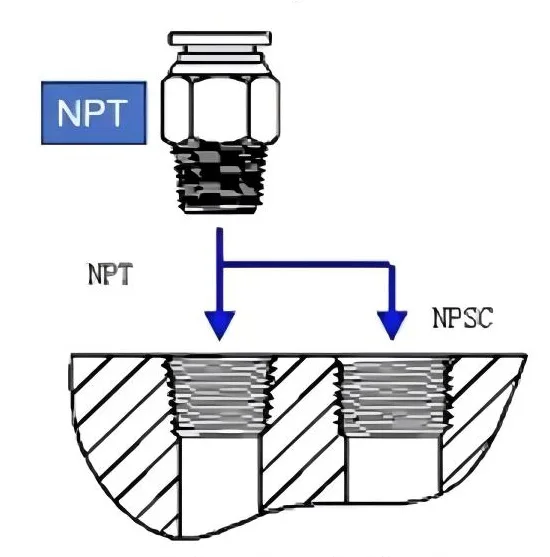
Unlike G threads, NPT threads inherently provide sealing through the thread’s shape and taper. However, in practice, PTFE tape or other sealing materials are often used to enhance the seal, especially in high-pressure applications.
G Thread Pros & Cons
Advantages:
- Strong Universality:
Follows the British Standard (BS), making G threads highly versatile for various pipe connection scenarios. - Low Cost:
Compared to NPT and PT threads, the manufacturing cost of G threads is lower, making them suitable for situations where high sealing performance is not required.
Disadvantages:
- Weaker Sealing Performance:
G threads have relatively weaker sealing capabilities and are not suitable for use in high-pressure or high-temperature environments.
NPT Thread Mark Symbols
| Name | Symbol | Formula | Name | Symbol | Formula |
|---|---|---|---|---|---|
| External Diameter | d | Tooth Height | h₁ | h₁ = 0.8t | |
| Mean Diameter | d₂ | Distance from Pipe End to Base | l₂ | ||
| Inner Diameter | d₁ | Effective Length | l₁ | ||
| Pipe End Internal Diameter | dt | dt = d₁ – 12/16 | Angle | φ | φ = 1°47’24” |
| Thread Pitch | t | Taper | 2tanφ | 2tanφ = 1:16 | |
| Theoretical Height | H | H = 0.866t |
NPT Thread Dimensions (Sizes) Chart
NPT thread sizes are based on nominal pipe size and follow strict regulations for pitch and taper. Below is a size conversion chart for commonly used NPT thread sizes:

This table provides detailed information about the thread length, thread diameter, pipe end internal diameter, and tooth height for different sizes of NPT threads. Including this chart in the article will offer readers a clear reference for the dimensions of various NPT thread sizes.
NPT Thread Application
NPT threads are widely used in high-pressure systems in industries such as oil, natural gas, chemical processing, and automotive. Due to their excellent sealing performance, NPT threads are particularly suitable for fluid transmission systems, ensuring leak-free connections in heavy-duty applications.
3. G Thread vs NPT Thread, What is the Differences?
Below we briefly list the difference between G thread and NPT thread:
Thread Type
- G Thread: A non-tapered, cylindrical thread with a 55° profile. It requires external sealing materials such as PTFE tape to prevent leaks.
- NPT Thread: A tapered thread with a 60° profile. It provides a natural seal through the deformation of the threads when tightened, although additional sealing materials are sometimes used.
Shape Characteristics
- G Thread: The G thread’s depth and pitch can vary depending on the size and application. The thread itself has no taper, so both internal and external threads are cylindrical.
- NPT Thread: NPT threads have a specific taper (1:16), which ensures a tight fit as the threads deform when tightened. The thread profile is strictly regulated to ensure a good seal.
Applications
- G Thread: Common in water pipes, construction, and drainage systems. Due to its non-standard nature, G thread applications can vary in different regions and industries.
- NPT Thread: Widely used in high-pressure fluid transmission systems for water, oil, gas, and chemicals. NPT threads are more common in the U.S. and industries requiring more reliable and high-pressure sealing.
Standard Specifications
NPT and G threads have some differences in their standard specifications. Below is a comparison of the key specification parameters for NPT and G threads:
| Specification Parameter | NPT Threads | G Threads |
|---|---|---|
| Basic Thread Diameter (inches) | 1.5, 2.5, 3.5, 4.5 | 0.410, 0.625, 0.850, 1.063 |
| Threads Per Inch | 1.5, 2.5, 3.5, 4.5 | 0.410, 0.625, 0.850, 1.063 |
| External Diameter (inches) | 24, 11, 8, 6 | 36, 11.5, 6, 4 |
| Thread Angle | 60° | 60° |
| Thread Length (inches) | 36, 11.5, 6, 4 | 24, 11, 8, 6 |
Advantages and Disadvantages
G thread and NPT thread serve similar purposes but differ in their design, sealing mechanisms, and applications. G threads are more common in Europe and Asia, where they are used in water systems and construction, while NPT threads are more prevalent in North America, particularly in industries requiring secure, high-pressure sealing.
| Feature | G Thread | NPT Thread |
|---|---|---|
| Sealing Performance | Requires sealing materials for tightness | Provides natural sealing through thread taper |
| Machining Difficulty | Easier to machine | More complex due to taper and thread count |
| Strength | Strong connection but relies on external sealing | High torque and side pressure resistance |
| Application Suitability | Best for low to medium pressure systems | Ideal for high-pressure piping systems |
4. Are NPT and G Threads Compatible?
No, NPT and G threads are not inherently compatible due to differences in their design, angle, and sealing mechanisms. Let’s break down the reasons why these two thread types are not interchangeable:
1. Thread Angle
- NPT (National Pipe Thread): NPT threads have a 60° thread angle. This profile is part of what gives NPT threads their sealing capability, as the threads deform slightly when tightened to create a seal.
- G Thread (British Standard Pipe – BSPP): G threads (also called BSPP, British Standard Parallel Pipe) have a 55° thread angle. This difference in angle means that even if the threads could be forced together, they would not properly engage, leading to poor fit and leak risks.
2. Taper vs. Parallel
- NPT: NPT threads are tapered, meaning the diameter of the thread decreases gradually along the length of the thread. Tapered threads form a tighter seal as they are tightened.
- G Thread: G threads are parallel (cylindrical), with a uniform diameter along the thread length. G threads rely on the use of sealing materials like PTFE tape or O-rings to create a seal, unlike NPT, which can seal directly through thread deformation.
3. Sealing Mechanism
- NPT: NPT threads seal through thread deformation and taper, often without the need for additional sealing materials (though PTFE tape or other sealing materials may be used for added security).
- G Thread: G threads do not self-seal. They rely on external sealing materials (such as washers or PTFE tape) applied to the connection to prevent leaks. This makes the sealing mechanism fundamentally different from NPT threads.
4. Size Compatibility
Even though NPT and G threads may have similar diameters for certain sizes, the differences in thread angle, taper, and sealing mechanisms make them incompatible in practice. Forcing NPT and G threads together may damage the threads and lead to leaks or connection failure.
When choosing between G thread and NPT thread, consider the specific application requirements – whether you need enhanced sealing for high-pressure systems or a more straightforward, standardized connection for low-pressure systems.


